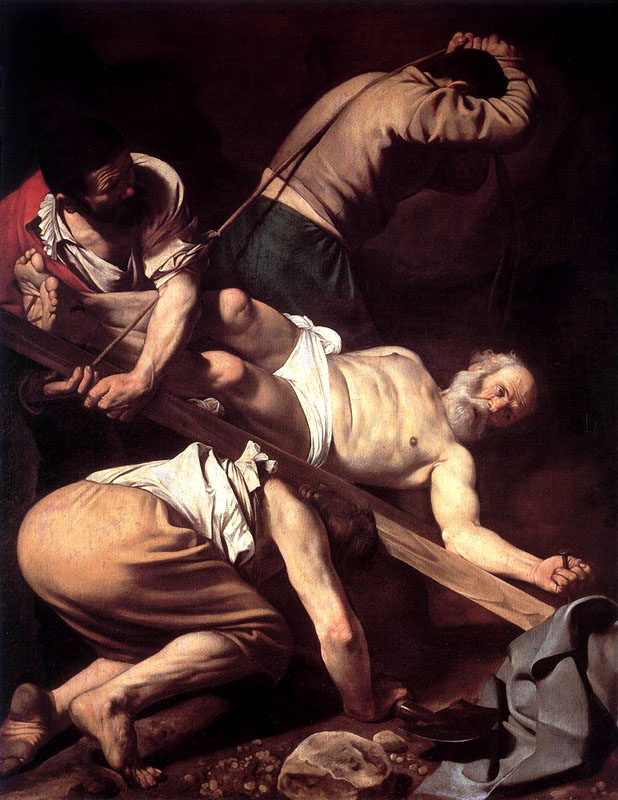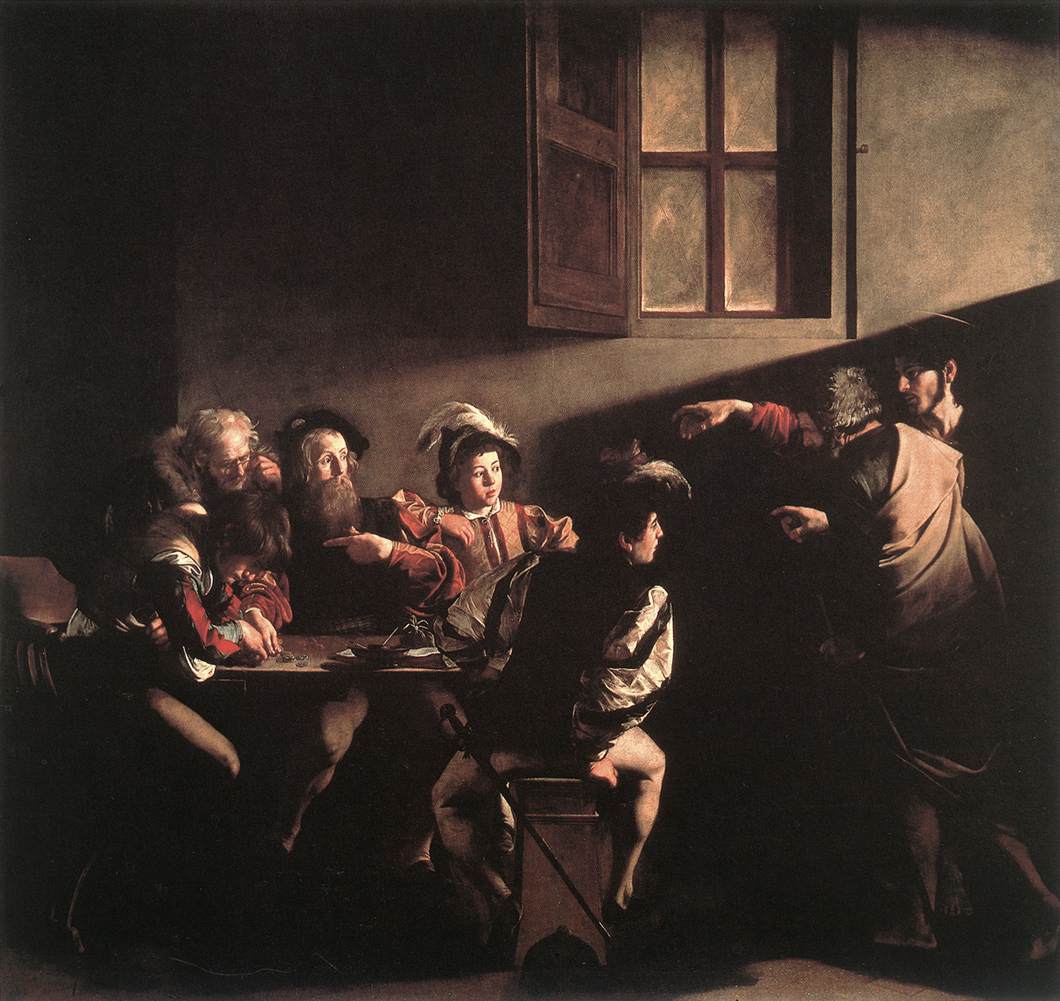Today in the class of Social Sciences, we have done several things. Paqui has said that it's my turn to write the journal today because Maribel hasn't come to the class because she has been at the hospital. Also Virginia has said that she can't do the journal the day that she has to do it.
Later we have remembered the main features of painting with a power-point presentation:
- Use of oil painting.
- Predominance of colour over drawing.
- Use of warm colours.
- Constrast of light and shadow(Chiaroscuro).
- Realism.
- Movement.
- Complex composition(foresthortened figures,asymmetry,curved lines...) in order to shock the audience.
ITALY: Michelangelo Caravaggio:
- THE CONVERSION OF SAINT PAUL ON THE WAY TO DAMASCUS:
Source: http://www.jennytaylorart.com/images/other_member_pics/jstaylorart/Caravaggio-Conversion-of-St-Paul-1601.jpg
- THE ENTOMBENT OF CHRIST:


Source: http://upload.wikimedia.org/wikipedia/commons/0/03/Caravaggio-Crucifixion_of_Peter.jpg
- THE CALLING OF SAINT-MATTHEW:

Source: http://upload.wikimedia.org/wikipedia/commons/e/ee/CaravaggioContarelli.jpg
- DEATH OF THE VIRGIN: the woman who appeared on this painting is a pregnant prostitute who had died drowned dead in the Tiber River. The painting was considered to be immoral by the Church.
.jpg!xlMedium.jpg)
Source: http://uploads3.wikipaintings.org/images/caravaggio/the-death-of-the-virgin-1603(1).jpg!xlMedium.jpg
FLANDERS: Peter Paul Rubens:
- THE DESCENT FROM THE CROSS: this painting is an example of contrast of light and shadow( Chiaroscuro).

Source: http://upload.wikimedia.org/wikipedia/commons/5/53/Peter_Paul_Rubens_066.jpg
- THE ADORATION OF THE MAGI,BY SEBASTIANO RICCI:
%3B_Sebastiano_Ricci.jpg)
- EQUESTRIAN PORTRAIT OF THE DUKE OF LERMA:this painting is in the Prado Museum and his composition is very complet.

Source: http://www.dukemagazine.duke.edu/issues/050608/images/050608-lg-equestrianportraitofthedukeoflermaweb.jpg
- THE THREE GRACES: the woman of the left is the same as the woman in the middle. This are an example of the woman of this period (with curves in their body and white skin). The people of that time thought: to wash your body was a sin.

Source: https://upload.wikimedia.org/wikipedia/commons/9/9c/Rubens,_Peter_Paul_-_The_Three_Graces.jpg
- HERCULES DRUNK, BEING LED AWAY BY A NYMPH:

Source: http://www.backtoclassics.com/images/pics/peterpaulrubens/peterpaulrubens_the_drunken_hercules.jpg
HOLLAND: in the Low Countries the main subjects were not religious, but more based on ordinary life and bourgeois tastes: portraits, landscapes, scenes of ordinary life.
-Rembrandt Van Rijn: has more than ninety self-portraits.
- ANATOMY LESSON OF DR.NICOLAES TULP: on this painting the doctor (surgeon) is doing an autopsy to this body and the people around are seen to them. Autopsies in this period were done in theatres because they were public. The corpse belonged to a hung criminal. The people of that time thought: to wash your body was a sin.

- SYNDICS OF THE DRAPERS' GUILD:

Source:http://en.wikipedia.org/wiki/File:Rembrandt_-_Klesveverlaugets_forstandere_i_Amsterdam.jpg
- THE SLAUGHTERED OX:

Source: http://hem.bredband.net/b153434/Works/slaughtered-ox.jpg
And we will continue tomorrow in class, so tomorrow we will study the last Baroque painter (Johannes Vermeer from Delft) and his work.
Today also I have added new interesting word in my glossary:
-knight: caballero
-with his back turned down: de espaldas.
-backwards: hacia atrás.
-to drown: ahogarse.
-corpse: cadáver.
-how you dare: ¿Cómo te atreves?
-Flanders: Rubens.
-vinegar: vinagre.
-caustic soda: sosa cáustica.
-drunk: bebido,borracho.
-leather: cuero.
-drapers: pañero.
-guild: gremio.
-slaughtered ox: buey desollado.
Finally, the bell has rung and Paqui has told us to review the new things that we have learned.
See you!

8 comments:
Hi class!
Congratulations Siria for the journal. I'm going to tell you some little mistakes:
-In the fifth line of your journal you has written "Later we have remember the main features of painting..." I think that the correct verbal tense is "We have remembered", in present perfect.
-In the explanation of "Anatomy lesson of Dr. Nicolaes", you have a mistake in the last setence. You forgot to write the word "there". The correct sentence I think is "The autopsy in this period were realised in theatre because ther were public" You also have a little spelling mistake in "theatre".
I hope I will wrong with my mistakes and you wrote the journal perfect.
See you on Monday!
Hi Siria! Your journal is really good. I have seen some little mistakes:
-In the first paragraph of your journal you have written "because she has been to the hospital" I think that the correct verbal tense is "becaus she has been IN the hospital".
-In the explanation of "Anatomy lesson of Dr. Nicolaes" you have written "the doctor (surgeon) is doing a autopsy". The correct form is: the doctor (surgeon) is doing AN autopsy.
You can also include more information like:
-Rembrandt Van Rijin has more than ninety self-portraits.
-"Anatomy lesson of Dr. Nicolaes Tulp, made by Rembrandt, we can add a curiosity about this painting: the corpse was a beheaded criminal.
-The people of that time thought: to wash your body was a sin.
Good work Siria. See you !!!
In the third line of my previous comment I have written becaus, instead of because. Sorry !
Hello class!
Siria your journal are perfect, you have some mistakes but these haven't any importance! The last day I haven't gone a class, because I have been in the hospital, I'm sorry Siria, jajaj.
Congratulations Siria!
Thanks!I'm gointo to correct the mistakes now.
See you tomorrow!
Hello class!
Siria, your journal is very complete, it has some mistakes, but even so it's perfect.
You have put a lot of pictures with a little explanation and you put all the words of the glossary.
Congratulations Siria, see you tomorrow!
Hy classmates! Siria a very good journal! The mistakes are corrected but I think that you can add about The Three Graces of Rubens that the two girls (because two are the same) are the Rubens'wifes. See you in class:)
Hello,
The corrections are in general good. The only mistake is Maribel has been at the hospital.
These are the last mistakes nobody has found:
- witha PowerPoint presentation
- works of painting on the whiteboard
- The names of the paintings have to be in Italic font and all the words in capital letters, except for the prepositions and articles. For example: The Conversion of Saint Paul on the Way to Damascus
- the woman who appeared on this painting is a pregnant prostitute who had died drowned in the Tiber River
- this painting is an example
- The Adoration of the Magi you’ve included is not by Rubens, but by Sebastiano Ricci. You have to look for Rubens painting. He made two versions. Look for the one in El Prado Museum
- …and his composition is very complete ??? I don’t understand what you wanted to say here. You can talk about the colours, one of Rubens’ features
- …is the same as the woman in the middle
-... with curves in their body
- HOLLAND: in the Low Countries
- Dr.Nicolaes Tulp: on this painting
- people around are Choose the one you prefer
- Autopsies in this period were done in theatres because they were public. The corpse belonged to a hung criminal. Behead means “decapitar” and this corpse preserved his head.
- This sentence doesn’t fit here: “The people of that time thought: to wash your body was a sin”. We talked about this when we were commenting on the Three Graces, because when we were talking about how the ideal of beauty has changed, María Muñoz Alcañiz said what she had read about hygiene and we were talking about why people didn’t clean regularly.
- we will study the last Baroque painter
- backwards
You could add what I said about Rubens (what his other work was and who painted most of the paintings attributed to him) or some of the comments I made about the paintings.
That's all. See you!
Post a Comment